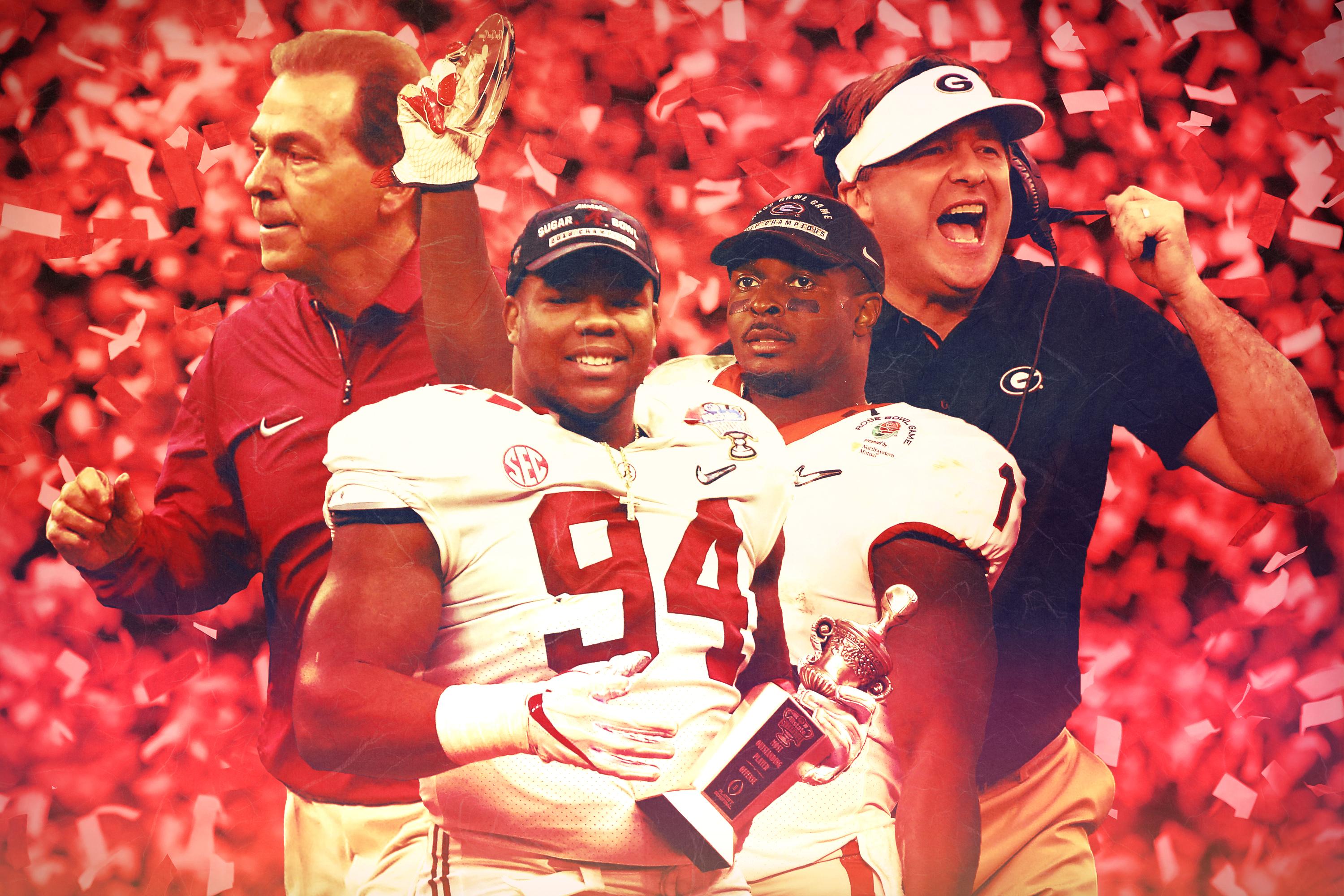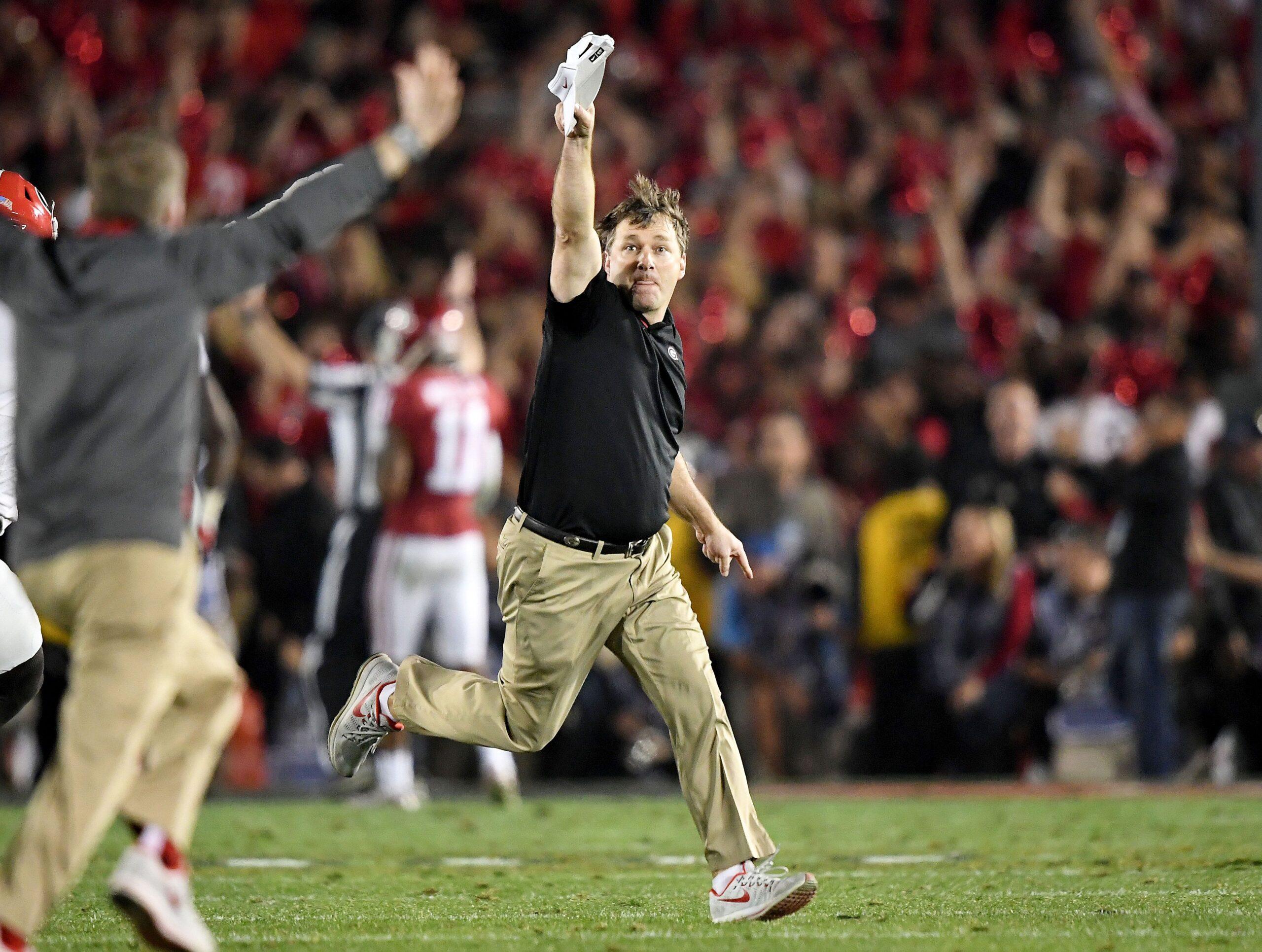The College Football Playoff Comes Down to Alabama and Alabama’s Clone
Just like after the 2011 season, the national championship features a matchup of SEC teams. But don’t mistake this for a conference triumph. It’s a testament to the power of the Process—and the program that best modeled itself after Nick Saban’s Crimson Tide.
Congratulations to the Process on securing yet another national championship.
SEC fans will gloat about college football’s most powerful league once again putting two teams in the national championship game, the second time that the conference has pulled off this historic feat. But we all know that Ole Miss, Vanderbilt, Tennessee, and Florida will not play for the title next Monday night in Atlanta. (Goodness, especially not Tennessee and Florida.) It’ll be Alabama, the program playing in its sixth national championship game in the past nine seasons, and Georgia, the program that has most successfully modeled itself after Alabama under former Nick Saban defensive coordinator Kirby Smart.
The Crimson Tide’s 24–6 win over Clemson in the Sugar Bowl semifinal looked a lot more like the average Alabama game of the past decade than it looked like Bama’s two recent national championship matchups with the Tigers. As it turns out, Clemson poses significantly less of an existential threat to the Tide when it doesn’t have Deshaun Watson. The Tigers ran 70 plays for 188 yards, an average of 2.7 per play, and quarterback Kelly Bryant set up 14 Alabama points with a pair of third-quarter interceptions. This game produced a brief moment of joy when Bama ran a play that resulted in a toe-tapping touchdown reception for 308-pound defensive lineman Da’Ron Payne, but otherwise there was no excitement — just the way Saban likes it.
On the other hand, Georgia’s Rose Bowl win over Oklahoma was the most exciting game of the season. The Bulldogs beat the Sooners 54–48 in double overtime, a contest that began with five touchdowns in 16 minutes and ended with multiple fourth-quarter lead changes. It might be hard to see Saban’s influence in this one; Alabama hasn’t played in a game in which the teams combined to score 100 points this millennium.
But what got Georgia to the national championship was a second-half showing bolstered by a dominant defense and a prolific running game. Heisman Trophy winner Baker Mayfield baked in the first half, with the Sooners racking up 31 points and 360 yards of offense — more than Georgia had allowed to any team in an entire game during its 12 wins this season. In the second half, however, Oklahoma scored just seven offensive points and was held to 147 total yards. (The Sooners averaged 44.0 points and 583 yards per game before playing the Dawgs.) After halftime, Mayfield went 10-of-16 passing for 80 yards with a touchdown and an interception, pedestrian numbers for the most efficient quarterback in college football history. In two overtimes, the Sooners got 24 yards and were forced to settle for a pair of field goal attempts, one of which was blocked.
Meanwhile, Bulldogs running backs Nick Chubb and Sony Michel racked up 326 rushing yards with five touchdowns on 25 carries. Georgia’s offensive line opened up holes that even Uga could run through:
And in a game that featured more than 1,000 yards of total offense, the MVP might have been Georgia linebacker Roquan Smith. He was everywhere in the second half and overtime, from sideline:
To sideline:
Smith’s speed and elusiveness were on full display as he shed blockers in pursuit of Oklahoma ballcarriers. Normally, the words “speed and elusiveness” are used to describe skill-position players like running backs, but Smith has both qualities in spades and is also incredibly mean. His Butkus Award might be as meaningful as Mayfield’s Heisman.
The big defensive adjustment that turned the game? As Chris B. Brown pointed out, it was Sabanesque: Georgia added defenders to the box after getting torched in the first half. If there was one offense this season that had enough firepower to blow past Alabama and win the national championship like Watson and Clemson did, it was probably Mayfield’s Oklahoma. But an Alabama clone got to it first.
The all-SEC national title game between LSU and Alabama after the 2011 season was widely considered an affront to college football. The Tigers beat the Tide 9–6 during the regular season, but Alabama captured the championship by winning the title game rematch 21–0. The premise of two division rivals playing for the crystal football while fellow contenders were left out brought about the creation of the College Football Playoff.
This season’s all-SEC matchup is nothing like that one. Georgia and Alabama have played twice since Alabama’s current reign of dominance began in 2009: once in the 2015 regular season, a 38–10 Crimson Tide victory, and once in the 2012 SEC championship, a classic 32–28 Bama triumph. The two programs are in the same league, but this meeting is as rare as any of the other potential title games would have been. Clemson and Georgia played season openers against each other in 2013 and 2014; Clemson and Oklahoma faced off in the 2014 Russell Athletic Bowl and the 2015 Orange Bowl; Alabama took on Oklahoma in the 2014 Sugar Bowl. Two teams on opposite sides of a 14-team superconference are about as likely to play each other as any two blue bloods. It’s a flaw in the system.
What binds these teams more than conference affiliation is the Saban thread. Since Alabama became college football’s hegemonic power, many other schools have tried to co-opt the Tide’s success by hiring his spawn to run their programs. Will Muschamp uglied up Florida, then somehow parlayed a 28–21 record with the Gators into the head-coaching job at South Carolina. Florida tried an equally doomed version of the same damn thing by hiring Jim McElwain as Muschamp’s successor. We can also count Derek Dooley, who went 4–19 in conference play at Tennessee, as a branch of Nick Saban’s tree. (Best of luck with Jeremy Pruitt, Vols fans.) The urge to copy the most successful thing in a given realm seems smart, until you realize the bar these schools set for themselves: Their task is now to be better than the best team at doing the things it does best. Former Saban offensive coordinator Jimbo Fisher won a national championship at Florida State, but he was building the ACC’s best version of Alabama. The degree of difficulty with that is lower, since Alabama is not in the ACC.

But Smart is getting the job done. Yahoo Sports’ Pete Thamel profiled Smart’s spin on the Process, which involved spending upward of $500,000 on nine additional support staffers and a 60-person recruiting operation. It’s working: Alabama had the best recruiting class in 247Sports’ composite rankings in 2011, 2012, 2013, 2014, 2015, 2016, and 2017, a more impressive reign even than the Tide’s four national championships under Saban. This year, Georgia is blowing the Tide out of the water, with six five-star recruits to Alabama’s one. The Process isn’t about one man’s genius; it’s about building a machine with more smart people working harder than anyone else.
Georgia now looks similar to Alabama behind the scenes, and it looks similar to Bama on the field. Both Alabama and Georgia have one, two, or maybe three running backs who might as well be cheat codes; both have offensive lines that mash; both have swarming, merciless defenses; both have quarterbacks who sometimes can be weak links.
We cannot quibble with the path Georgia took to get to the title game. It rolled to an 11–1 regular season, dramatically stomped Auburn — the lone team to whom it lost — in the SEC championship, and has now secured a playoff win over college football’s best offense. Famously, no Saban disciple has ever beaten Saban as a head coach. But no former Saban assistant has ever built a team capable of doing the things this Georgia group has done.
If you can tune out the drone of the wave of ESS! EEE! SEE! chants, Alabama-Georgia presents something fascinating: college football’s two finest machines smashing into each other at full force.